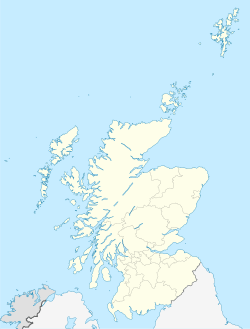Elginhaugh facts for kids
| Region | Scotland |
|---|---|
| Coordinates | 55°53′40″N 3°05′12″W / 55.894438°N 3.0867672°W |
| Type | Roman fort |
| Part of | Roman empire |
| History | |
| Founded | AD 77-78 |
| Abandoned | AD 87 |
| Site notes | |
| Excavation dates | 1986 |
| Archaeologists | William S. Hanson |
Elginhaugh Roman Fort was an ancient Roman army base. It was built in the 1st century AD. You can find its remains in Midlothian, Scotland.
This fort is special because it's the most fully dug-up timber (wooden) fort from the Roman Empire. It was an "auxiliary" fort, meaning it housed supporting troops, not the main legions. The fort was built during the time of the Flavian emperors (1st century AD). It is located about 1 kilometer west of the modern town of Dalkeith. This is south-east of Edinburgh.
The fort was first spotted from the air in 1979. It gets its name from a small village nearby called Elginhaugh. Dr. William Hanson led a full excavation of the fort and its large annex in 1986-87. He is now a Professor of Roman Archaeology at the University of Glasgow.
Contents
What was Elginhaugh Fort like?
The excavations at Elginhaugh helped us understand Roman forts better. They showed that auxiliary forts generally had a similar layout. However, each fort also had its own unique details.
Soldiers and Horses Together
One important discovery was about how soldiers and horses lived. It was common for them to be housed together in "stable-barracks." These buildings had space for both men and their horses.
The number and arrangement of these buildings at Elginhaugh were unusual. This suggests the fort didn't house a standard Roman army unit. Instead, it was likely home to a "vexillation" of cavalry. A vexillation was a smaller group of soldiers, often detached from a larger unit.
The Fort's Annex Area
The archaeologists also studied a large area next to the fort called the "annex." This area was probably used for military activities too. It showed that how the annex was used changed quite a bit over a short time. This was different from the main fort, which stayed more consistent.
When was the Fort Used?
The fort was used for a specific period, from about AD 79 to AD 87. We know this from coins found at the site. One important group of coins was a "foundation hoard" found in the principia. The principia was the main headquarters building of the fort.
What We Learned from Finds
The finds at Elginhaugh give us a very precise timeline for many Roman objects. For example, we found evidence that rough pottery was made locally. This means the Roman soldiers might have used local craftspeople.
There was also proof that the soldiers used hand-held artillery pieces. These were small machines used to launch projectiles. Scientists also studied the environment around the fort. This helped them understand the local landscape and what food the soldiers ate.
Why was Elginhaugh Fort Important?
The main job of Elginhaugh Fort was likely to guard a nearby river crossing. This crossing was where Dere Street crossed the River North Esk. Dere Street was a very important Roman road running north and south. The River North Esk is a tributary of the River Esk, Lothian.
So, the fort served as a garrison post, or castellum. It was part of the Roman effort to control Scotland more permanently. This happened during and after the campaigns of Gnaeus Julius Agricola. Agricola was a famous Roman general.
After the Soldiers Left
There's also unique evidence that the site was used even after the soldiers left. It became a place to collect animals. The inside of the fort was covered with cobblestones. Two new wells were dug. Ditches were added across the annex to guide livestock.
The Coin Hoard Discovery
The Elginhaugh coin hoard is a collection of 45 denarii. Denarii were Roman silver coins. This hoard helped date the fort's construction to AD 77-78. The archaeologists believed it was a "foundation deposit" for the Principia. This means it was deliberately buried when the building was started.
Questions About the Dating
However, the exact dating has been questioned by David Woolliscroft. He argues that only 21 of the 45 coins were found together in a stack. The latest of these stacked coins was dated to AD 71. The AD 77-78 date comes from a single coin found near the hoard. But it wasn't definitely part of the main stacked group.


